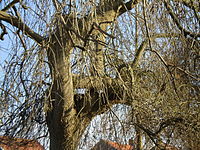Weeping ash
| Weeping ash | ||
|---|---|---|
|
Weeping Ash ( Fraxinus excelsior 'Pendula')
|
||
| place | Schwanberg | |
| state | Styria , Austria | |
| Geographical location | 46 ° 47 '5.5 " N , 15 ° 13' 27.3" E | |
|
|
||
The weeping ash or suspended ash ( Fraxinus excelsior 'Pendula') is a cultivar ( Cultivar ) of the European ash ( Fraxinus excelsior ).
description
The weeping ash is a tree that reaches heights of 12 to 15 meters. The branches and twigs that grow downward in an arch often reach the ground. The tree crown of the weeping ash is a tightly closed canopy and is slightly wider than that of the common ash and the branches of the crown have an irregular, bizarre shape. As with the common ash, the leaves are deep green and pinnate.
The flowers of the weeping ash are hermaphroditic like those of the common ash , whereby one gender can be reduced depending on the individual ( trioce ).
Taxonomy
William Aiton , head of the Botanical Garden in Kew , mentions Fraxinus excelsior 'Pendula' (English weeping ash ) in his book Hortus Kewensis from 1789. Fraxinus excelsior 'Pendula' does not correspond to any taxonomic rank of the ICBN .
use
The weeping ash was very popular in England in the Victorian era . The habit allows it to be used as a natural arbor . The dense growth provides shade and privacy. The weeping ash is mostly found as a solitary tree in parks and on farms and cemeteries.
All of the weeping ash specimens are derived from a single specimen found in a field in the parish of Gamlingay in Cambridgeshire in the British Isles in the early 18th century . The original copy was small. All of the larger trees that came on the market from the middle of the 18th century were made by grafting . The trunk of a common ash serves as a base . The crown with the pendulum branches comes from the original weeping ash.
Ferdinand Fintelmann , court gardener on Pfaueninsel , suspected that the weeping ash and the common ash are different species. To check this, in 1822 he grew about a thousand plants grown from the seeds of the weeping ash. However, none of the trees showed the peculiar growth ( weeping shape ) of the weeping ash with the hanging branches, but common ash trees developed.
The population of the weeping ash is just as threatened by the ash dieback as the population of the common ash. Because the entire population of black ash trees consists only of clones , the black ash tree has less chance of survival. The cause of ash dieback is an attack by the Chalara fraxinea fungus .
gallery
A weeping ash diseased with ash dieback on the B 2 in Weilheim in Upper Bavaria
literature
- Peter Schütt, Horst Weisgerber, Hans J. Schuck, Ulla Lang, Bernd Stimm, Andreas Roloff: Encyclopedia of Deciduous Trees . Nikol, Hamburg 2006, ISBN 3-937872-39-6 .
Individual evidence
- ^ William Aiton: Hortus Kewensis , Volume III, London, 1789, p. 445. scanned at biodiversitylibrary.org .
- ^ Negotiations of the Association for the Promotion of Horticulture in the Royal Prussian States, Volume 6 . Berlin, 1830, p. 314





